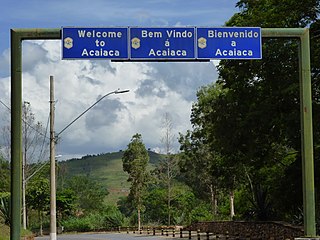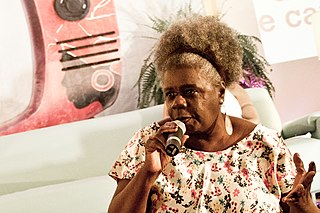Related Research Articles

Indigenous peoples once comprised an estimated 2,000 tribes and nations inhabiting what is now the country of Brazil, before European contact around 1500 AD.
Afro–Latin Americans or Black Latin Americans are Latin Americans of full or mainly sub-Saharan African ancestry.

The Tupinambá are one of the various Tupi ethnic groups that inhabited present-day Brazil since before the conquest of the region by Portuguese colonial settlers. In the first years of contact with the Portuguese, the Tupinambás lived in the whole East coast of Brazil, and the name was also applied to other Tupi-speaking groups such as the Tupiniquim, Potiguara, Tupinambá, Temiminó, Caeté, Tabajara, Tamoio, and Tupinaé, among others.

The Ragamuffin War or Ragamuffin Revolution was a Republican uprising that began in southern Brazil, in the province of Rio Grande do Sul in 1835. The rebels were led by generals Bento Gonçalves da Silva and Antônio de Sousa Neto with the support of the Italian fighter Giuseppe Garibaldi. The war ended with an agreement between the two sides known as Green Poncho Treaty in 1845.
The Fundação Nacional dos Povos Indígenas or FUNAI is a Brazilian governmental protection agency for Amerindian interests and their culture.

Indigenous peoples of Mexico, Native Mexicans or Mexican Native Americans, are those who are part of communities that trace their roots back to populations and communities that existed in what is now Mexico before the arrival of Europeans.

Portuguese is the official and national language of Brazil being widely spoken by most of the population. Brazil is the most populous Portuguese-speaking country in the world, with its lands comprising the majority of Portugal’s former colonial holdings in the Americas.

Education in Brazil has had many changes. It first began with Jesuit missions, that controlled education for a long time. Then, two hundred years after their arrival, their powers were limited by the Marquis of Pombal. Shortly after the Jesuits' power was limited, the Brazilian government took over education and it is now run by the government through the Ministry of Education.
The Suyá, self-denomination Kisêdjê, are indigenous people in Brazil, at the headwaters of the Xingu River.
Willem Leo Marie (Leo) Wetzels is a full professor at the Vrije Universiteit Amsterdam in the Netherlands and Directeur de recherche at Laboratoire de Phonétique et Phonologie (LPP), CNRS/Sorbonne-Nouvelle in Paris. He is Editor-in-Chief of Probus International, the Journal of Latin and Romance Linguistics.

Anti-discrimination laws in Brazil are present in the Constitution of Brazil, in the labour law, in the child and adolescent law, in the ageing law, and in the penal code.

The Ticuna are an indigenous people of Brazil (36,000), Colombia (6,000), and Peru (7,000). They are the most numerous tribe in the Brazilian Amazon.

Events in the year 1967 in Brazil.

Events in the year 1982 in Brazil.

Maria da Conceição Evaristo de Brito is a Brazilian writer. Her work is marked by her life experiences as an Afro-Brazilian woman, which she calls escrevivência—a portmanteau of escrita (writing) and vivência. She was born into a humble family and is the second oldest of 9 siblings, being the first in her household to earn a university degree. She helped her mother and aunt with washing clothes and deliveries, while studying.
Carl Ratner is an American cultural psychologist. He is the Director of the Institute for Cultural Research and Education in the United States and an adjunct professor at the Universidad Autónoma del Estado de Morelos in Cuernavaca, Morelos, Mexico. He is a member of the International Association for Cross-Cultural Psychology. He is known for his theory of "macro cultural psychology", which is based on the works of Soviet psychologist Lev Vygotsky. He was a Fulbright Fellow at Jawaharlal Nehru University from 2006 to 2007.
Brazil Without Homophobia (BWH) or Programa Brasil Sem Homophobia is an initiative launched in 2004 by the Special Secretariat for Human Rights meant to tackle homophobia through public policy.

Vaccination in Brazil includes all the practice and social issues related to vaccines in Brazil.

Afro-Brazilian culture is the combination of cultural manifestations in Brazil that have suffered some influence from African culture since colonial times until the present day. Most of Africa's culture reached Brazil through the transatlantic slave trade, where it was also influenced by European and indigenous cultures, which means that characteristics of African origin in Brazilian culture are generally mixed with other cultural references.
References
- ↑ "L11645". www.planalto.gov.br. Retrieved 2020-07-13.
- ↑ Ângelo, Francisca Navantino P. de (2019). "Os Dez Anos da Lei Nº 11.645/2008: Avanços e Desafios". Cadernos CEDES (in Portuguese). 39 (109): 357–378. doi: 10.1590/cc0101-32622019216733 . ISSN 0101-3262.
- ↑ Guimarães, Selva (2015-04-06). "The teaching of Afro-Brazilian and indigenous culture and history in Brazilian basic education in the 21st century". Policy Futures in Education. 13 (8): 939–948. doi:10.1177/1478210315579980. ISSN 1478-2103. S2CID 148329289.
- ↑ Russo, Kelly; Paladino, Mariana; Russo, Kelly; Paladino, Mariana (2016). "A lei n. 11.645 e a visão dos professores do Rio de Janeiro sobre a temática indígena na escola". Revista Brasileira de Educação (in Portuguese). 21 (67): 897–921. doi: 10.1590/S1413-24782016216746 . ISSN 1413-2478.
- ↑ Gonçalves, Lays (2018-02-09). "Povos Indígenas no contexto do ensino superior: os desafios do acesso e da permanência na UFPR". Campos - Revista de Antropologia. 17 (2). doi: 10.5380/cra.v17i2.54275 . ISSN 2317-6830.
- ↑ Andrade, Edson Dorneles de (2019). "O Indígena Como Usuário da Lei: Um Estudo Etnográfico de Como O Movimento da Literatura Indígena Entende e USA a Lei Nº 11.645/2008". Cadernos CEDES. 39 (109): 321–356. doi: 10.1590/cc0101-32622019217105 . ISSN 1678-7110.